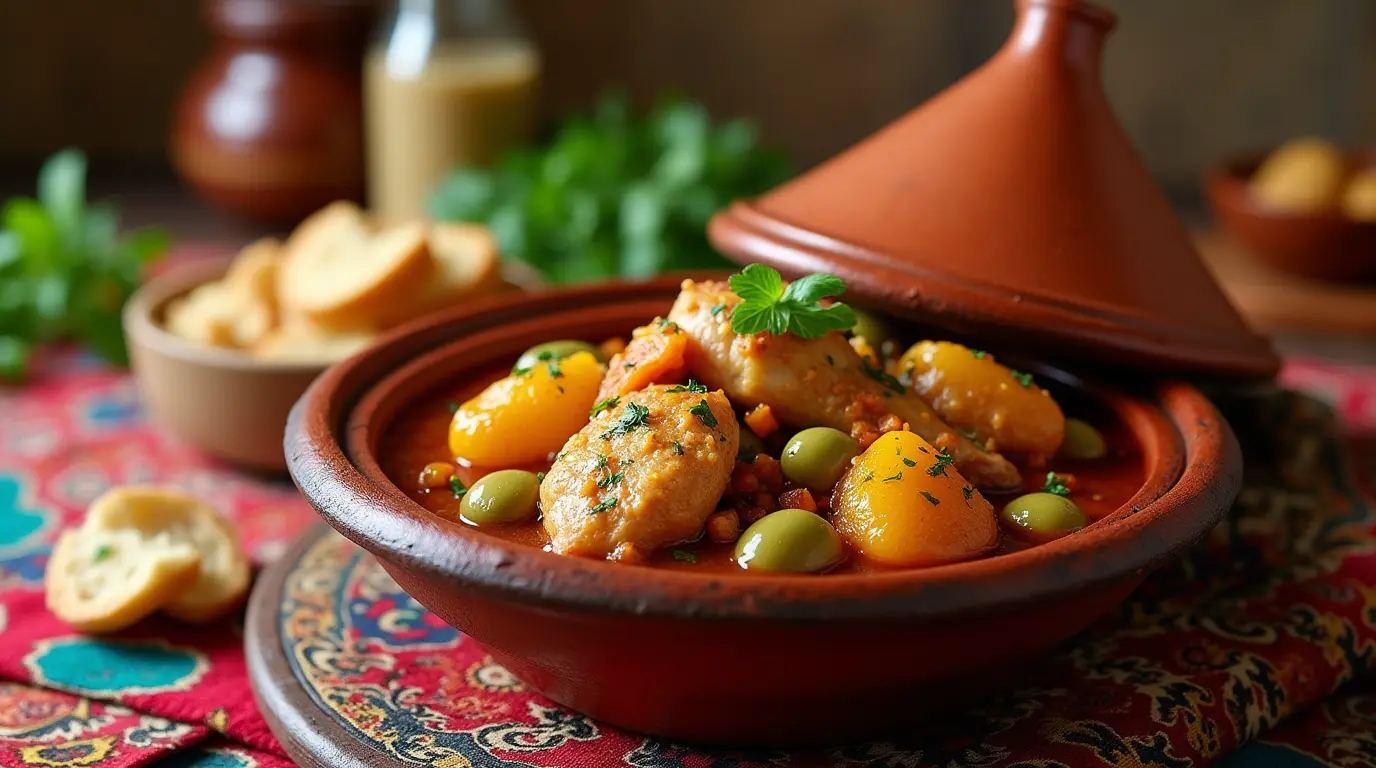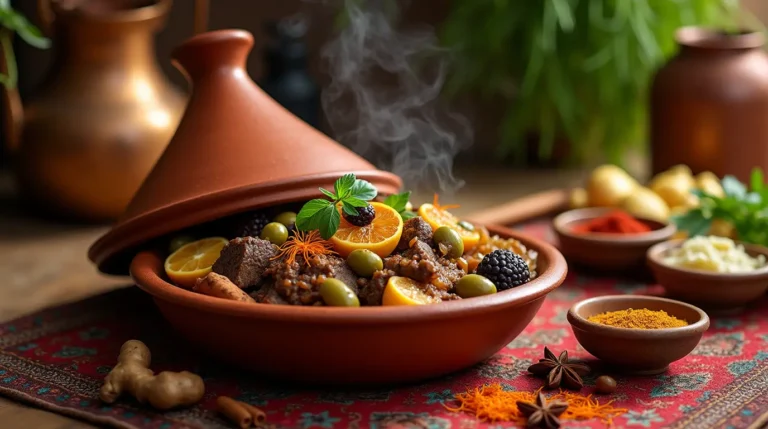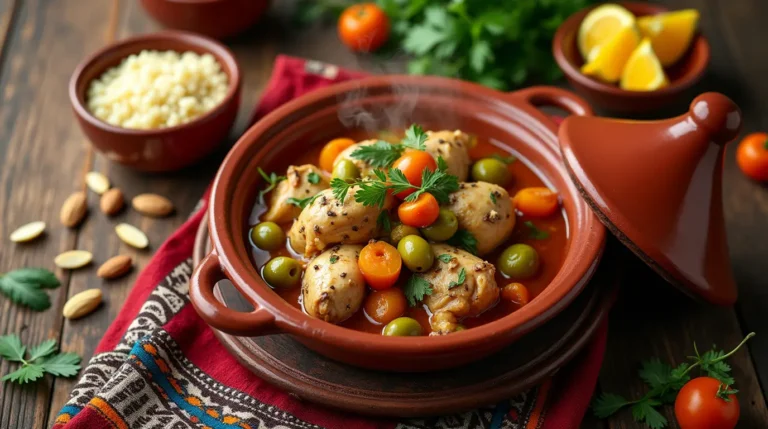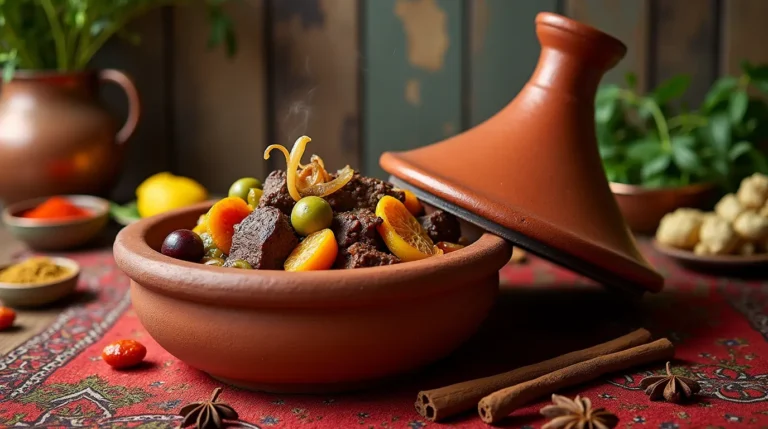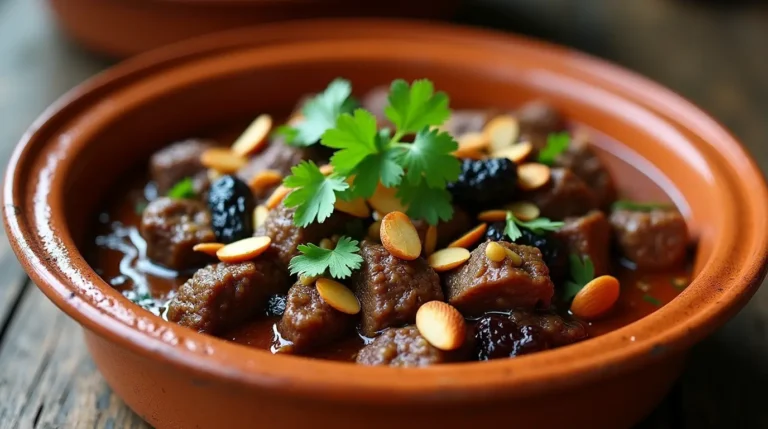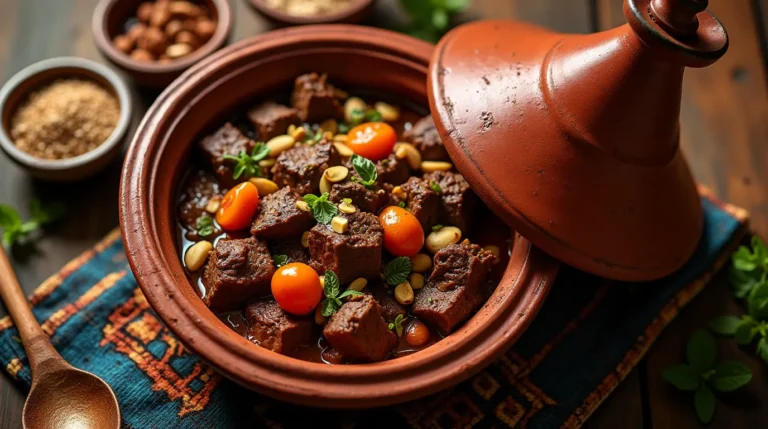How to Make the Perfect Moroccan Chicken Tagine
Have you ever tasted a dish so rich in flavor that it transported you to another place entirely? That’s the magic of a well-made Moroccan chicken tagine. This traditional North African dish combines tender chicken, aromatic spices, and sweet-savory contrasts to create something truly special. Whether you’re a seasoned cook or just starting your culinary journey, I’m here to guide you through creating this magnificent one-pot wonder in your own kitchen.
I fell in love with tagine during my travels through Morocco, where I watched local cooks transform simple ingredients into extraordinary meals using nothing more than time, patience, and generations of cooking wisdom. Today, I’m sharing everything I’ve learned about making an authentic chicken tagine that will impress family and friends alike.
What You’ll Need
Ingredients:
- 8 chicken thighs, bone-in and skin-on (about 2 pounds)
- 2 large onions, thinly sliced
- 4 cloves garlic, minced
- 2-inch piece of fresh ginger, grated
- 2 preserved lemons, quartered (or substitute with 1 fresh lemon, zested and juiced)
- 1 cup green olives, pitted
- 1/2 cup dried apricots, chopped
- 1/4 cup raisins or golden sultanas
- 2 tablespoons honey
- 1 cinnamon stick
- 2 bay leaves
- 1 teaspoon ground cumin
- 1 teaspoon ground coriander
- 1 teaspoon paprika
- 1/2 teaspoon ground turmeric
- 1/4 teaspoon cayenne pepper (adjust to taste)
- 1/4 teaspoon ground cardamom
- Pinch of saffron threads (optional, but recommended)
- 1 1/2 cups chicken stock
- 1/4 cup fresh cilantro, chopped
- 1/4 cup fresh parsley, chopped
- 2 tablespoons olive oil
- Salt and freshly ground black pepper, to taste
Equipment:
- Traditional clay tagine pot (if available) or a large Dutch oven
- Measuring cups and spoons
- Sharp knife and cutting board
- Mixing bowls
- Wooden spoon
Now, let’s dive into the step-by-step process of creating your perfect Moroccan chicken tagine!
Step 1: Prepare and Marinate the Chicken
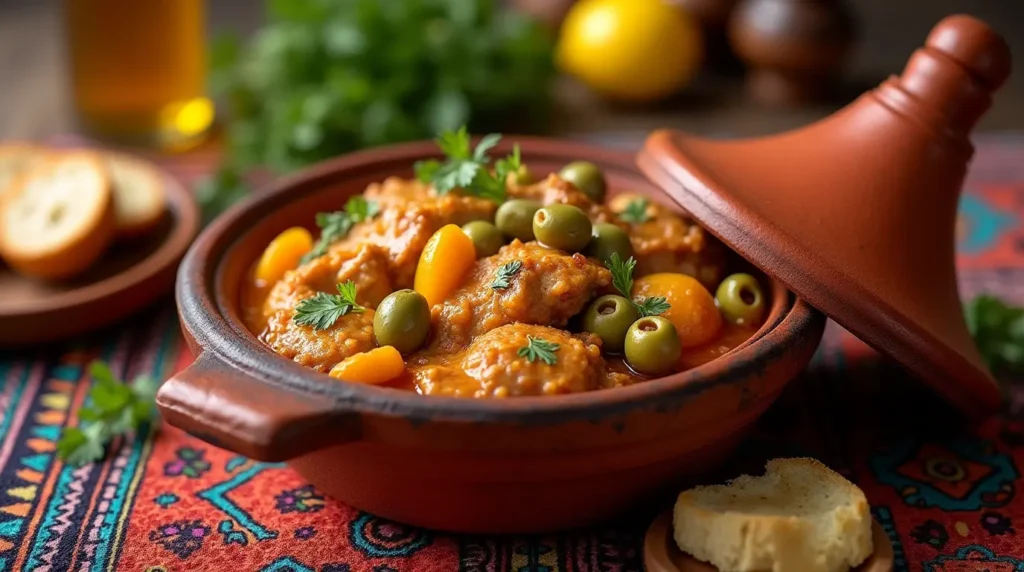
Begin by patting your chicken thighs dry with paper towels. This helps the spices adhere better and promotes browning. Place the chicken in a large bowl and season generously with salt and freshly ground black pepper.
In a small bowl, mix together the ground cumin, coriander, paprika, turmeric, cayenne pepper, and cardamom. Sprinkle half of this spice mixture over the chicken, then add half of the minced garlic and half of the grated ginger. Using your hands (wear gloves if you prefer), massage the spices into the chicken to ensure even coating.
Cover the bowl with plastic wrap and let the chicken marinate in the refrigerator for at least 2 hours, preferably overnight. This marination period allows the flavors to deeply penetrate the meat, resulting in a more flavorful dish.
Pro tip: If you’re short on time, even 30 minutes of marination will make a difference!
Step 2: Prepare Your Tagine or Dutch Oven
If you’re using a traditional clay tagine pot and it’s new, you’ll need to season it first. Soak the entire tagine in water for at least 2 hours, then let it dry. Rub the inside with olive oil and place it in a cold oven. Turn the oven on to 300°F (150°C) and let the tagine heat slowly for about 2 hours. This prevents cracking when you use it for cooking.
If you’re using a seasoned tagine or a Dutch oven, simply wipe it clean and prepare it for cooking.
A traditional tagine has a wide, shallow base and a tall, conical lid that traps and circulates steam, keeping the contents moist. If you’re using a Dutch oven instead, that’s perfectly fine – you’ll still create a delicious dish!
Step 3: Brown the Chicken
Heat 2 tablespoons of olive oil in your tagine base or Dutch oven over medium-high heat. If using a clay tagine, remember to use a heat diffuser and keep the heat lower to prevent cracking.
Working in batches to avoid overcrowding, place the chicken skin-side down and sear until golden brown, about 5-7 minutes. Then flip and brown the other side for 2-3 minutes. We’re not trying to cook the chicken through at this point – just developing flavor through browning.
Transfer the browned chicken to a plate and set aside. Don’t worry about any browned bits stuck to the bottom – that’s flavor gold!
Step 4: Create the Aromatic Base – Chicken Tagine
In the same tagine or Dutch oven, add the sliced onions and cook over medium heat until they begin to soften and turn translucent, about 5 minutes. Add the remaining garlic and ginger, stirring constantly to prevent burning, for about 1 minute until fragrant.
Sprinkle in the remaining spice mixture, the cinnamon stick, and bay leaves. Stir well to coat the onions with the spices and cook for another 2 minutes. The aromas filling your kitchen at this point will be absolutely heavenly!
If the mixture seems dry or starts to stick to the bottom, add a splash of the chicken stock to deglaze the pan, scraping up all those flavorful browned bits.
Step 5: Add Fruits and Build Layers
Now comes the magic of Moroccan cooking – the sweet and savory contrasts. Add the preserved lemon quarters (or lemon zest if using fresh), green olives, dried apricots, and raisins or sultanas to the onion mixture. Drizzle the honey over everything for a touch of sweetness.
Arrange the browned chicken pieces on top, skin-side up, nestling them into the mixture but keeping them partially exposed.
In Moroccan cooking, this layering technique is crucial – it allows the flavors to meld while ensuring each ingredient maintains its integrity.
Step 6: Add Liquid and Begin the Slow Cook – Chicken Tagine
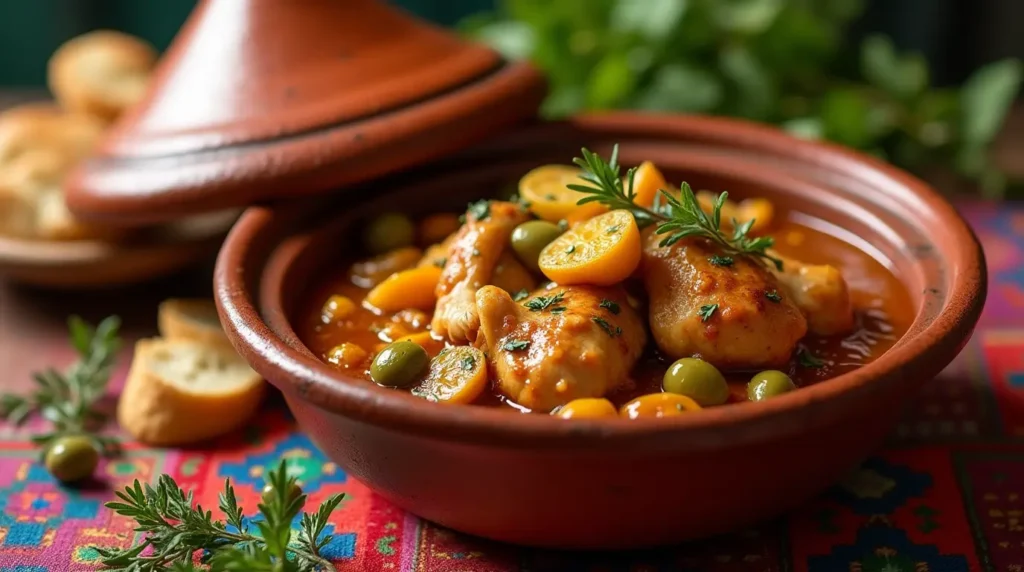
In a small bowl, combine the chicken stock with the saffron threads (if using), allowing them to steep for a minute to release their color and flavor.
Carefully pour the stock mixture around the chicken (not over it, to keep the skin crisp). The liquid should come about halfway up the sides of the chicken, not covering it completely.
If using a traditional tagine, place the conical lid on top. If using a Dutch oven, cover with its lid. The tight seal created by either lid will trap moisture and create the perfect environment for the slow-cooking magic to happen.
Step 7: Slow Cook to Perfection – Chicken Tagine
Now for the most important part – the slow cook. If using a clay tagine on the stovetop, make sure you have a heat diffuser underneath and keep the heat on the lowest setting. Alternatively, you can place your tagine or Dutch oven in a preheated 325°F (165°C) oven.
Let the tagine simmer gently for about 1 to 1.5 hours. The long, slow cooking process is what makes tagine special – the flavors deepen, the chicken becomes fall-off-the-bone tender, and the sauce thickens to a luxurious consistency.
Resist the urge to repeatedly lift the lid to check on it – each time you do, you release precious steam and extend the cooking time. Trust the process!
Step 8: Check for Doneness – Chicken Tagine
After about an hour, carefully remove the lid (watch out for the steam!) and check the chicken for doneness. It should be very tender, almost falling off the bone. The internal temperature should read at least 165°F (74°C) on an instant-read thermometer.
If the sauce seems too thin, you can remove the chicken pieces temporarily, increase the heat slightly, and simmer the sauce uncovered for 5-10 minutes to reduce it to your desired consistency. Then return the chicken to the pot to warm through.
Step 9: Rest and Garnish
Once your tagine is cooked to perfection, remove it from the heat and let it rest for about 10 minutes with the lid slightly ajar. This resting period allows the flavors to settle and meld together even further.
Just before serving, sprinkle the fresh chopped cilantro and parsley over the top. The bright, fresh herbs provide a beautiful contrast to the rich, slow-cooked flavors of the dish.
Step 10: Serve and Enjoy!
Traditional Moroccan meals are communal affairs, with everyone gathering around to share from the same dish. Serve your tagine directly from the cooking vessel if possible (placing the hot tagine on a wooden board or trivet to protect your table).
The perfect accompaniment to chicken tagine is either fluffy couscous, crusty bread for soaking up the delicious sauce, or both! For an authentic experience, tear off pieces of bread and use them to scoop up the tender chicken and sauce.
You can also serve with a side of harissa (Moroccan hot sauce) for those who enjoy an extra kick of heat.
Tips for Tagine Success
- Be patient: The magic of tagine comes from slow cooking. Rushing it will result in tough meat and underdeveloped flavors.
- Balance is key: Authentic Moroccan tagine has a perfect balance of sweet, savory, and aromatic elements. Don’t skip ingredients like the dried fruits or preserved lemon, as they’re essential to this balance.
- Experiment with preserved lemons: If you can find them, preserved lemons add an authentic touch that’s hard to replicate. You can make your own by preserving lemons in salt for several weeks, or find them at specialty food stores.
- Use bone-in chicken: For the most flavor and succulence, bone-in, skin-on chicken thighs are ideal. They won’t dry out during the long cooking process.
- Make it ahead: Like many stews, tagine often tastes even better the next day after the flavors have had time to develop further.
Conclusion
Congratulations! You’ve mastered one of Morocco’s most beloved dishes. The beauty of tagine is in its versatility – once you understand the basic technique, you can experiment with different meats, vegetables, and flavor combinations.
This chicken tagine recipe honors the traditions of Moroccan cooking while being accessible to home cooks everywhere. The complex flavors might make your dinner guests think you spent all day in the kitchen (and technically you did!), but the actual hands-on time is quite minimal.
Remember, the essence of Moroccan cooking is about patience, layering of flavors, and sharing good food with those you love. So gather your friends and family, break some bread, and transport them to the vibrant markets and riads of Morocco through this delicious chicken tagine.

